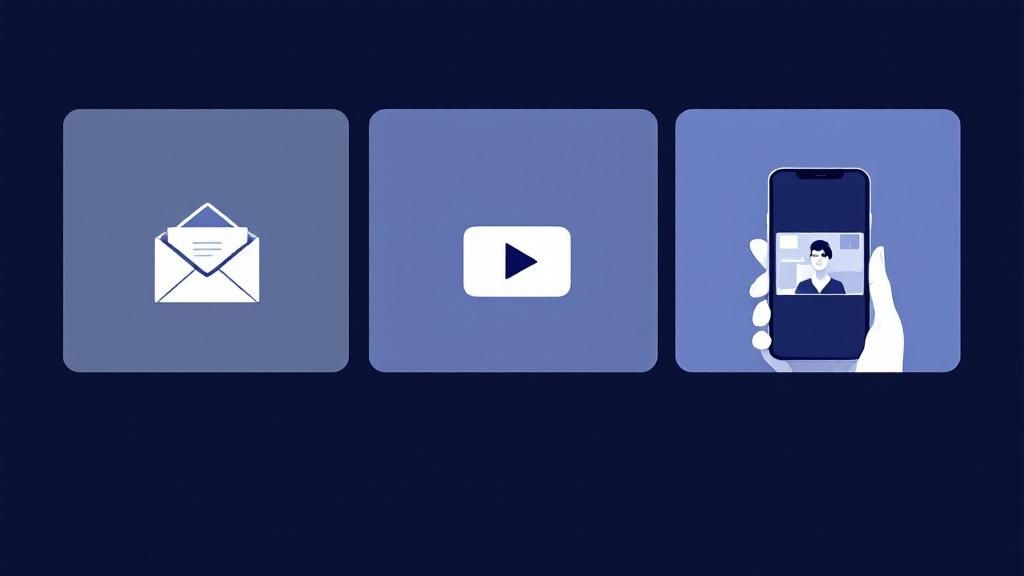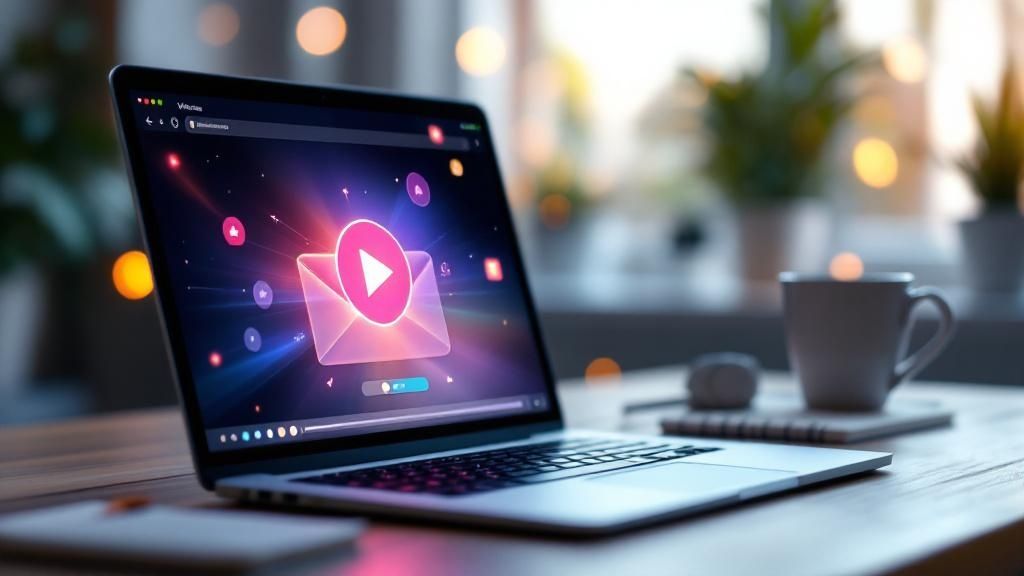In a world of overflowing inboxes, standing out is no longer a luxury—it’s a necessity. Marketers are constantly searching for that next breakthrough strategy to capture attention and drive real results. The answer might be simpler and more dynamic than you think: the video email blast.
But what does that actually mean, and how do you get it right? We’ve compiled the most common questions marketing professionals ask about using video in email to give you a clear, practical guide.
Q: What is a video email blast, and how does it differ from a regular campaign?
A: Think of a video email blast as a strategic evolution of a standard email campaign. While a regular blast relies on text and static images to convey a message, a video email blast uses dynamic visual content as its centerpiece. It’s not just about attaching a video; it’s about shifting the entire experience from passive reading to active viewing.
The core difference lies in the method of communication. A standard email tells your audience something. A video email blast shows them. This simple change transforms a one-dimensional message into a multi-sensory experience that can explain complex ideas faster, add a human touch to your brand, and forge a much stronger emotional connection.
This isn’t just an enhancement; it’s a strategic shift from simply informing to creating an experience. Our guide to using video in email offers a deeper dive into this transformative approach.
Q: Why does video increase open and click rates in email marketing?
A: The answer is rooted in human psychology. Our brains are hardwired to prioritize visual information—processing it an incredible 60,000 times faster than text. Motion and sound naturally capture our attention in a way that static content simply can’t.
This neurological preference translates directly into powerful marketing metrics:
- Higher Open Rates: Just including the word “video” in an email subject line can significantly boost open rates. It acts as a powerful signal to subscribers that the email contains engaging, easy-to-digest content.
- Skyrocketing Click-Through Rates (CTR): Studies consistently show that emails containing video can increase CTR by as much as 200-300%. A compelling video thumbnail with a play button is an almost irresistible call-to-action.
- Increased Engagement: Video holds attention longer than text. This extended engagement time gives your message more opportunity to resonate and builds a stronger brand connection, making subscribers more likely to take the next step.
A video email blast turns your message from a monologue into a conversation. It’s the difference between sending a letter and making a personal visit, creating a far more engaging and persuasive experience for your audience.
Q: What types of video content work best in email blasts?

A: The most effective video is one that aligns perfectly with your campaign goal. It’s less about Hollywood production value and more about matching the right format to the message. Before you hit record, ask: “What do I want the viewer to feel or do after watching?”
Here are three proven formats that deliver results:
- Product Explainers: Perfect for clarifying complex features or announcing a new product. A short, animated explainer video can break down functionality and showcase value much more effectively than a long block of text. Goal: Educate and drive adoption.
- Customer Testimonials: Nothing builds trust like social proof. A genuine video of a happy customer sharing their success story can shatter skepticism and resonate deeply with prospects who are on the fence. Goal: Build credibility and overcome objections.
- Personalized Greetings: A simple video from a sales rep saying, “Hi [Name], I made this for you,” can cut through the noise of automated outreach. It shows you’ve invested personal effort, making the recipient far more likely to engage. Goal: Create a human connection and start a conversation.
Explore more ideas in our guide on the three types of video to use in your email marketing.
Q: How long should a video in an email blast be to keep attention?

A: Respect your audience’s time. For most email marketing purposes, the sweet spot for video length is between 30 and 90 seconds. This is long enough to deliver a compelling message but short enough to prevent viewer drop-off.
- Under 30 seconds: Ideal for quick announcements, personalized greetings, or showcasing a single, powerful feature.
- 30-60 seconds: The perfect length for most product explainers and customer testimonials.
- 60-90 seconds: Best for mini-case studies or brand stories that require a bit more narrative depth.
Pushing past 90 seconds is a risk. The goal is to deliver a concise, high-impact message that leaves them wanting more, not checking the clock.
Q: Is it better to embed video or use a thumbnail/animated GIF that links to a landing page?
A: This is a critical technical question with a clear answer: always use a thumbnail image or animated GIF that links to a landing page.
While embedding a video so it plays directly in the email sounds great in theory, it’s a practical nightmare. Major email clients like Gmail and many versions of Outlook do not support embedded video. This means many of your subscribers will see a broken, unprofessional-looking element instead of your video.
The thumbnail-to-landing-page method is superior for several reasons:
- Universal Compatibility: It works flawlessly across all email clients.
- Better Deliverability: Emails with large, embedded files are more likely to be flagged as spam.
- Superior Analytics: By driving traffic to a landing page, you can track detailed video metrics like view duration, play rate, and post-view actions. This is essential for measuring marketing campaign effectiveness. An animated GIF thumbnail is particularly effective at grabbing attention and boosting clicks.
Q: How can personalization make a video email blast more effective?

A: Personalization is what elevates a broadcast into a conversation. It’s the key to making a recipient feel like the message was crafted specifically for them, not for a list of thousands. A truly effective personalized video goes far beyond simply inserting a first name.
Meaningful personalization involves using data to make the content hyper-relevant. For instance:
- Address a Specific Pain Point: “I saw your company is hiring for sales roles, and I wanted to show you how our tool can help onboard new reps faster.”
- Reference Past Behavior: “Since you downloaded our e-book on SEO, here’s a quick video on how to apply those principles to your website.”
- Create a Unique Visual: Show a personalized screenshot of their website within the video or mention their company name on a virtual whiteboard.
Personalization is what gives your video email blast its stopping power. It’s the difference between an email that gets instantly deleted and one that actually gets a reply. By showing you understand your audience’s specific context, you earn both their attention and their trust.
Q: What are common mistakes to avoid when using video in emails?
A: Even a great video can fail if the surrounding campaign has flaws. Here are four common mistakes to steer clear of:
- A Vague or Missing Call-to-Action (CTA): Your video got them excited—now what? Always follow your video with a clear, specific, and compelling CTA button like “Book Your Demo Now” or “Get 20% Off Today.” Don’t leave them guessing.
- An Uninspired Thumbnail: Your thumbnail is your sales pitch for the video. A blurry, dark, or boring image will get ignored. Create a custom thumbnail that is bright, features a person’s face, or uses bold text to spark curiosity.
- Ignoring the Mobile Experience: Over half of all emails are opened on mobile devices. If your email isn’t responsive and your video isn’t optimized for a vertical screen, you’re frustrating a huge portion of your audience. Always test on mobile first.
- Forgetting the Sound-Off Default: Most platforms autoplay video on mute. If your message relies entirely on audio, it will be lost. Use bold on-screen text and burn-in captions to ensure your video is compelling even without sound.
Your Next Step: Scaling Video Creation with Confidence
The evidence is clear: video email blasts work. According to recent 2025 video marketing statistics, video continues to dominate as the preferred way for consumers to learn about products and services.
The biggest hurdle for many marketing teams is simply the creation process. How do you produce high-quality, personalized videos at scale without a massive budget or team? This is where video creation and automation platforms become essential. They simplify the process, allowing you to create on-brand, effective video content quickly.
For campaigns that need hundreds or even thousands of unique videos, manual creation isn’t just a mistake—it’s impossible. Solutions like Wideo’s video automation are built to handle this process seamlessly. By linking a data source (like a CRM) to a video template, you can generate hyper-personalized content that makes every recipient feel seen—all without lifting a finger for each individual video. This is how you scale your impact without scaling your workload.

